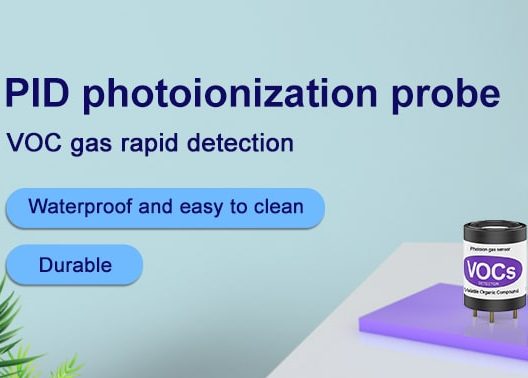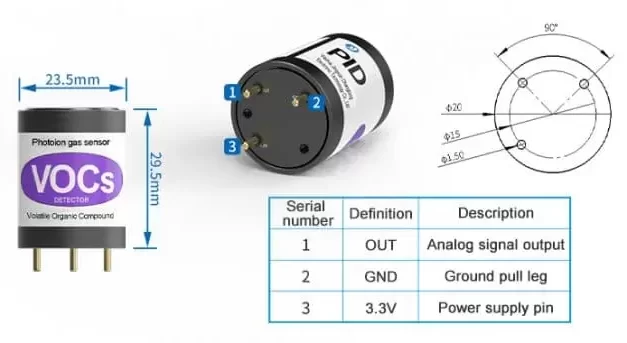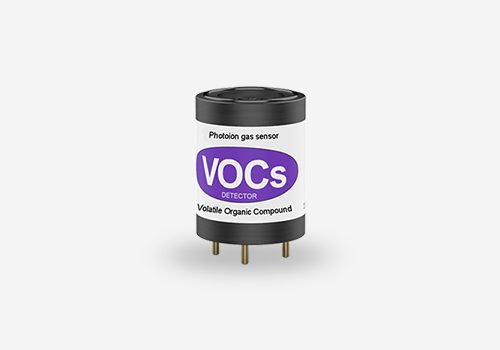A PID (Photoionization Detector) sensor is a type of gas detector that measures volatile organic compounds (VOCs) and other gases in the environment. It is widely use in industrial settings, environmental monitoring, and occupational safety applications. The composition and advantages of PID sensors are crucial to understanding their significance in gas detection and monitoring. In this essay, we will explore the composition, working principles, and advantages of PID sensors in detail.
Composition of PID Sensor:
A PID sensor consists of several key components that work together to detect and measure VOCs and other gases. The main components of a PID sensor include:

Lamp and UV Source: The heart of a PID sensor is a high-energy ultraviolet (UV) lamp. This lamp emits UV light with a specific wavelength, typically around 10.6 eV, which is capable of ionizing gas molecules.
Ionization Chamber: The ionization chamber is a crucial part of the PID sensor where the gas sample is introduced. When the UV light from the lamp interacts with the gas molecules in the ionization chamber, it ionizes the gas, creating positively charged ions and free electrons.
Electrodes: The ionization chamber contains two electrodes – a positively charged anode and a negatively charged cathode. These electrodes help to collect and measure the flow of ions and electrons generated by the ionization process.
Detector and Amplifier: The detector amplifier is responsible for converting the ionization current into an electrical signal, which is then measured and analyzed. Thus, the concentration of volatile organic compounds in the sample is determine.
Working Principles of PID Sensor:

The working principles of a PID sensor are based on the ionization of gas molecules by UV light and the subsequent measurement of the resulting ionization current. The operation of a PID sensor can be summarized in the following steps:
UV Ionization: When the gas sample enters the ionization chamber, it is expose to the high-energy UV light emitted by the lamp. This UV light has enough energy to ionize the gas molecules, causing them to lose electrons and become positively charged ions.
Ionization Current: The ionized gas molecules produce a flow of positively charged ions and free electrons within the ionization chamber. This ionization current is directly proportional to the concentration of VOCs and other gases in the sample.
Signal Detection: The electrodes within the ionization chamber collect the ions and electrons, generating an electrical signal. This signal is then amplified and measured to determine the concentration of VOCs in the gas sample.
Calibration and Analysis: PID sensors are calibrate to specific VOCs, and the measured ionization current is converted into a concentration value using calibration factors .
Advantages of PID Sensor:
PID sensors offer several advantages that make them valuable tools for gas detection and monitoring applications. Some of the key advantages of PID sensors include:

Wide Detection Range: PID sensor are capable of detecting a wide range of VOCs and other gases, making them versatile instruments for industrial, environmental, and safety applications.
Real-Time Monitoring: PID sensors provide real-time measurements of gas concentrations, allowing for immediate detection of leaks, spills, or other hazardous situations.
High Sensitivity: PID sensors are highly sensitive to low levels of VOCs, making them effective for detecting trace amounts of gases that may pose health or safety risks.
Rapid Response Time: PID sensors offer rapid response times, enabling quick detection and measurement of gas concentrations, which is critical in emergency response and safety applications.
Portable and Handheld Options: PID sensors are available in portable and handheld configurations, allowing for easy and convenient use in various field applications.
Selective Detection: PID gas sensors can calibrate specific volatile organic compounds, providing selective detection of target gases without interference from other compounds.
Data Logging and Connectivity: Many modern PID sensor offer data logging capabilities and connectivity options, allowing for data storage, remote monitoring, and integration with IoT platforms for comprehensive gas monitoring.
Low Maintenance: Sensors generally require minimal maintenance and calibration, contributing to their ease of use and cost-effectiveness.
Conclusion
In conclusion, PID sensor play a crucial role in gas detection and monitoring, offering a wide range of advantages such as wide detection range, real-time monitoring, high sensitivity, rapid response time, portability, selective detection,. The composition and working principles of PID sensors enable them to effectively measure volatile organic compounds and other gases, making them valuable tools for industrial, environmental, and safety applications. As technology continues to advance, PID sensors will likely see further improvements in sensitivity, connectivity, and usability, solidifying their position as essential instruments for gas detection and monitoring.
